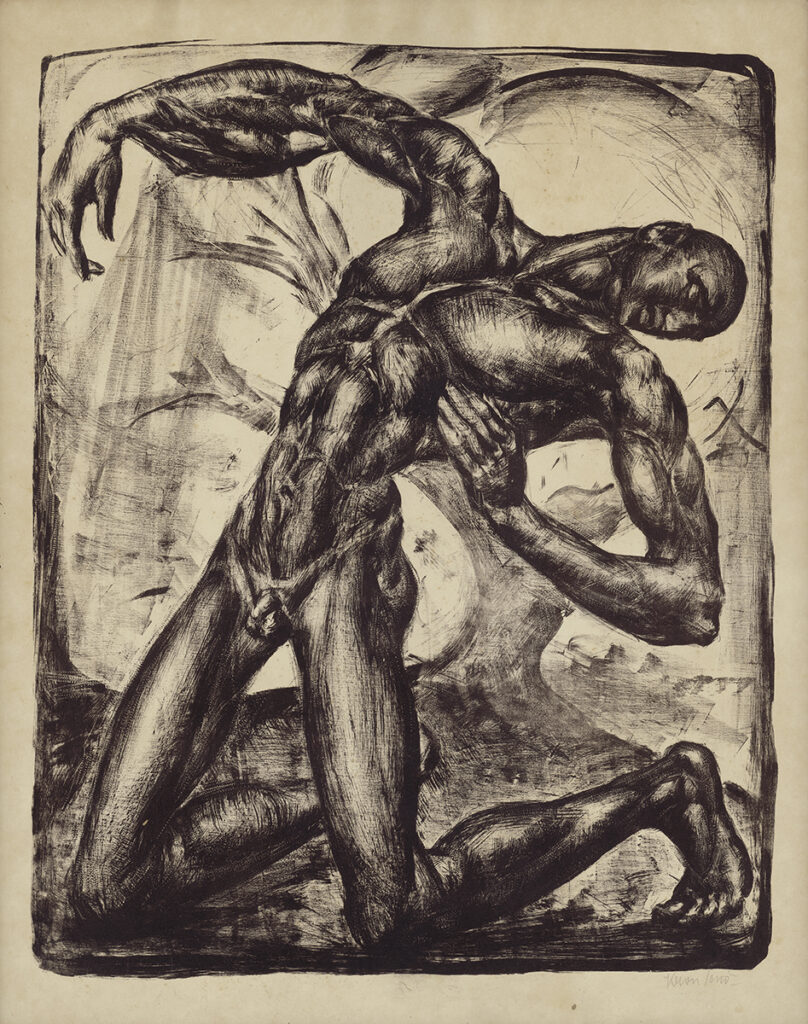The individual expression of a painter, illustrator and the poster author Eugen Krón is shown especially in his graphic art, e.g. the litography The Wounded. The constructivist composition with expressionistic tones shapes in the figure of a young man a symbol of inner suffering and pain very notable in the time of social persecution after the WWI not only in Slovakia. For Krón are characteristic extended proportions of athletic masculine bodies with rather small heads (influenced by Károl Kernestok) and overequipped limbs, the disciplined, but dynamic brushwork, the systematic construction of the figural composition, in the background with the abstract depiction of a tree top close well the whole scene. The extremeness of the artwork is intersected by the decorative – monumental features which refer to the power and majesty of the spirit fighting against the violence. The Wounded proves, that the author was definitely not satisfied with only the superficial depiction of a visual perception, but his thoughtful nature was also penetrating into the matter of perceived reality itself. Krón´s symbolism is the expression of an optimistic humanism which tried to point out the optimal solution to the social structure.
Eugen Krón, the founder of the Košice fine art modern style of the 20th century was born on May 5, 1882 in Sobrance into the family of a captain with six children. At the age of 14 he moved together with his parents to Budapest (1907), later studied at the Academy of Fine Arts at Prof. Teodor Zemplényi´s, Viktor Olgyai´s and Prof. Eduard Balla´s studios. In 1909 he was awarded the second prize in an art competition and a year later he was awarded a national prize for artistic qualities what enabled him to study in Munich, Paris and London. He also studied in the painters society in Nagybáni. After the outbreak of the WWI he served in the army and was taken captive in Tashkent, Uzbekistan. After the return to Budapest he got married and established a family. He joined the revolutionary movement, but he soon realised, that his revolutionary activities will not be without consequences and emigrated together with his family. At the end of 1920 he travelled to Romania to visit his brother, but he interrupted his journey in Košice to meet the painter Elemír Halász-Hradil who introduced him to the director of the museum Dr. Josef Polák. Josef Polák helped Krón to get permission to stay and so he settled in Košice where he founded the private school of graphics (1921) which was very important for the region and was run until 1927. His most famous students were Koloman Sokol, Konštantín Bauer, Jozef Fabini, Ľudovít Feld, Július Jakoby a others.
Krón´s activity in Košice belongs to his most productive creative period. He produced the graphic cycles – lithographies ´The Man of Sun´ and ´The Creative Spirit´. In 1928 he and his family left for Milan to visit his brother. But he was suddenly stricken by a family tragedy – his daughter died and his wife commited suicide. He consequently stopped his creative work for a while. He fought against the passivity with work and exhibitions. In the second half of the 1930s he linked his work to that of the Košice period and created a new grahic album ´Eros´, which was purchased by the Museum Civico in Milan. In the same way the new cycle of lithographies ´The new man´ was created.
In 1938 he got married for the second time to Maria Feldmann, former member of the Uzhgorod Theatre and an emigrant, too. During the WWII Krón joined the anti – fascist assembly, was taken captive and transported into the concetration camp in Calabria. The married couple was interned to the northern Italy. After the war they settled in the suburb of Milan where they lived and worked until 1956. In the same year they decided to return to Budapest where they spent the rest of their life. The Hungarian National Gallery organised an exhibition to celebrate Krón´s 90th anniversary, an honour to the famous artist.
Krón´s artwork is varied in the topics. It is characterized by the variety of chosen graphic techniques and different types of artistic approach. He regularly exhibited during his life around Hungary, Czechoslovakia and Italy. His works are not only at the Východoslovenská Gallery in Košice, but also in the Slovak National Gallery in Bratislava, in Nitra Gallery and in many other galleries throughout Hungary, Prague, Milan, Genove, Rome and in private collections.
Eugen Krón died at the age of 92, on January 7, 1974 in Budapest.
— Marta Hučková, April 2011
Bibliography
Kocianová, M.: Sociálno-kritické tendencie v slovenskej grafike r. 1918 – 1945. In: Vývojové tendencie, charakter a spôsob sociálnej reagencie na dobové problémy a umelecké osobnosti 20. – 30. r. 20. stor.. Diplomová práca, FF UK Bratislava, 1983, str. 53 – 75
Podušel, Ľ.: Maliarstvo, sochárstvo, grafika. In.: Biografia umelcov. Eugen Krón. NŠG, Nitra, 1995, str. 195
Samuelisová, K.: Eugen Krón – zakladateľ košickej výtvarnej moderny 20. stor. VŽ, r. XXXIV, 1989, č. 8
Inventory No.: G 483
Artist: Eugen Krón
Title: The Wounded
Date of origin: 1919 – 1920
Technical details: litography
Material: thin board etiolated
Dimensions: 53 × 42cm
Signature: in the right bottom corner: Kron Jenö
